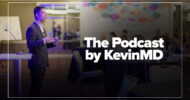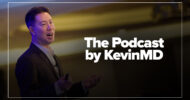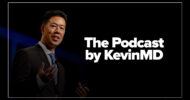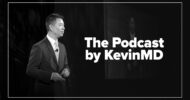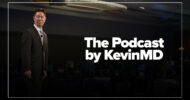Subscribe to The Podcast by KevinMD. Watch on YouTube. Catch up on old episodes!
Health care executive Blake Walker discusses his article, “From caregivers to collectors: Navigating the new landscape of patient payments.” He describes a perfect storm impacting provider groups: the significant rise in patient financial responsibility due to high-deductible health plans, the growth of health care consumerism where patients demand better experiences (with up to 50 percent willing to switch providers over billing issues), and the overwhelming administrative burden placed on staff using outdated systems not designed for patient collections. Blake argues that traditional practice management systems, prioritizing insurance reimbursement, are ill-equipped for today’s landscape, leading to lost revenue and patient frustration. The conversation emphasizes the need to unbundle patient billing from these systems and adopt modern, consumer-friendly solutions offering automation, transparency, clear communication (like omnichannel options recovering 70 percent of payments quickly), and multiple payment methods. Actionable takeaways include recognizing patient billing as a critical touchpoint, investing in technology that improves the patient financial experience, and automating routine tasks to free up staff and improve collections.
Our presenting sponsor is Microsoft Dragon Copilot.
Microsoft Dragon Copilot, your AI assistant for clinical workflow, is transforming how clinicians work. Now you can streamline and customize documentation, surface information right at the point of care, and automate tasks with just a click.
Part of Microsoft Cloud for Healthcare, Dragon Copilot offers an extensible AI workspace and a single, integrated platform to help unlock new levels of efficiency. Plus, it’s backed by a proven track record and decades of clinical expertise—and it’s built on a foundation of trust.
It’s time to ease your administrative burdens and stay focused on what matters most with Dragon Copilot, your AI assistant for clinical workflow.
VISIT SPONSOR → https://aka.ms/kevinmd
SUBSCRIBE TO THE PODCAST → https://www.kevinmd.com/podcast
RECOMMENDED BY KEVINMD → https://www.kevinmd.com/recommended
Transcript
Kevin Pho: Hi, and welcome to the show. Subscribe at KevinMD.com/podcast. Today we welcome Blake Walker, he’s a health care executive, and today’s KevinMD article is “From caregivers to collectors, navigating the new landscape of patient payments.” Blake, welcome to the show.
Blake Walker: Thanks for having me, Kevin. Great to be here.
Kevin Pho: All right, so just briefly share your story.
Blake Walker: I’ve been working in the health care space as an entrepreneur and founder for almost 20 years, pretty much my whole career. I started out doing SBA loans for doctors who were starting up their own practices back in the mid-2000s.
One of the interesting things I found doing that was that the doctors at that time were starting to see more and more of a struggle with patient AR building up on their balance sheets. That’s really what got me excited about trying to do something about patient billing and financing. I actually worked on an elective financing startup for a few years, basically trying to get better lending products for patients at the front desk.
Then, I ultimately founded Inbox Health around 2014, which is a patient billing communication platform that helps providers better engage with patients about balances, have better communication with them, and better answer their questions. I’ve been doing that for the last 11 years now. It’s pretty exciting to work with about 3,500 practices, give or take 15,000 providers across the U.S., and two and a half million patients using Inbox Health annually to manage and pay their health care bills. So, it’s been a fun ride, but obviously, it’s a huge space. Patient payments is half a trillion dollars at this point and continues to grow. It’s a huge problem in the space.
Kevin Pho: All right, so tell us more about that in your KevinMD article “From caregivers to collectors, navigating the new landscape of patient payments.” For those who didn’t get a chance to read your article, tell us more about it.
Blake Walker: It’s really just telling the story of how the role of the provider has been forced to shift as payer plan design has really changed over the last 25 years for a number of reasons. But at this point, patient out-of-pocket costs is about 27 percent of health care spending. The average patient that comes into a practice has a $4,000 family deductible. So if it’s anything that’s not going to be covered as part of their plan just before the deductible, you could expect them to have a large balance after they leave the office. And the reality of that is we don’t really know what that balance is going to be. It’s really hard to predict. That just creates a dynamic where the provider is sort of put in a position where they don’t know if they’re going to get paid.
As a physician, obviously, you’re trying to be there as a caregiver, as a health care provider, trying to make a patient healthy. Part of that ultimately comes back to the patient’s financial health that’s going to have an impact on their overall health care outcomes as well. So it’s a pretty complicated situation. It’s changed a lot, and I’m just trying to help provide some guidance as to how providers can start to think about this new changing role with the patient as they’re in their office.
How do they want to talk to patients about their expected costs? What do they want to set as ground rules at the front desk? There are things like card on file: is that something that you want for your practice? Is that sort of the relationship dynamic you want with your patients? Do you want to require it? Do you want to make it optional?
I think the reality of the situation today is it’s pretty complex trying to understand the benefits and coverage of any particular plan, both for the provider and for the patient. So, just doing what you can to educate yourself and your patients upfront about how their plan works and what costs might be expected, but then just being really thoughtful about how you engage with patients after the visit. You’re going to reach out to them. If it’s a $200, $300 bill, for most of your patients that might be a significant amount of money. How do you want to go through that experience in terms of your long-term relationship with that patient and how it affects their health care outcomes? So that’s what the article is trying to talk to a little bit. It’s relatively brief; it’s a huge issue to unpack.
It’s obviously changed a lot, and I think providers are starting to think more and more about it. The patient, if you think about the patient as a payer alongside UnitedHealthcare, Aetna, Blue Cross, the patient’s the fastest growing payer and, in many practices now, the single largest payer. But it’s one that we collect very little from. If we’re collecting from United, we might collect 90, 95 percent of what we’re submitting. But if we’re collecting from patients, we’re on average only collecting 40 percent. It’s taking 45, 60 days to actually collect from them. It’s very expensive. But then there’s that whole dynamic of what is it doing as we try to collect from that patient? If we’re more aggressive, are we letting them down as a caregiver to some degree? And it’s a fraught balance. So that’s what the article’s about and trying to get into the heart of that particular issue.
Kevin Pho: It’s something that I’m a primary care physician myself. I work for a hospital-based practice, but I talk to a lot of clinicians, and this whole issue of patient billing, especially in the spread of high-deductible health plans, where the onus of collecting payments comes from that clinician to the patient is becoming more and more of an issue. So tell us some of the difficulties currently, both from the clinician standpoint and the patient standpoint. Where of the current way that we do things, what’s the biggest problems with the current way we do things?
Blake Walker: I think it’s really three things. First, there’s the lack of transparency where the costs aren’t clear. It’s all but impossible to really get an accurate prediction of cost upfront. We don’t know what we’re going to code; we don’t know how it’s going to get reimbursed. A lot of patients come in with relatively complex insurance situations. They might be on Medicare, Medicare Advantage; they may have secondary insurance. If they’re on straight commercial coverage, we have to get a really good sense of what the deductible’s at and then have a really good sense of the fee schedule for that payer. That’s just really hard to do in real time while they’re in the office, pre-adjudication. So that’s the biggest one: we’re all dealing with a relatively uncertain circumstance.
Number two, I think, is that we don’t really have great tools out of the box in our EHRs to communicate with patients about costs. The status quo is still largely driven by paper statements. If you’re in a larger health system, you’re probably dealing with Epic. Eventually, they’ll get a MyChart bill in their MyChart account. But it’s still a surprise. As the consumer, as a patient, I’m still getting that and almost undoubtedly, I’m going to see it and be shocked and confused and wonder if it’s right. The people who I talk to when I pick up the phone to call don’t really have good answers for me. They don’t actually help. They’ll probably offer a payment plan at some point if I don’t pay for a while, or they just push into collections; even big health systems are pretty quickly getting pushed into collections now. So that’s going to be a really difficult dynamic both for the patient and the provider, who, especially for health system-based providers, are relatively removed from this whole thing. We, in many cases, joined that practice or sold our practice to put ourselves in a position where the administrative stuff is further from us. But then we’re also the front line with the patient. So you’re there with the patient who’s the one who’s frustrated about the balance.
And I think the last one is just straight-up affordability. The reality of the average American family is they aren’t sitting there with $4,000 in their bank account to throw at an unexpected health care expense, and health care expenses are sort of definitionally unexpected. So, that’s just the situation that we’re in where it’s a multifaceted problem. There aren’t great answers for any of it. But from our perspective, the best thing that we can do to help resolve this is to build a better communication system so that the patient and the provider can better communicate with one another to make that as seamless as possible and as consumer-oriented as possible on the back end.
Kevin Pho: So what you’re saying is absolutely correct. I think the majority of the way that physicians are reimbursed is still fee-for-service, and it’s kind of unpredictable in terms of how clinicians are going to bill or code for a certain visit, and there’s just a lot of opaqueness and surprise when the patient gets their bill. So you said that communication is one area that can certainly help this. So tell us about some of the approaches regarding that.
Blake Walker: For us, I think there are three big things. The first is the front desk. I think it starts with setting some expectation for the patient about cost. Everyone’s doing eligibility checks for the most part now; we should know whether or not they have a deductible. If they’re in a commercial plan, they most certainly do. And so just having that conversation, setting the expectation, planting a seed in baseline that there’s probably going to be a balance for this. OK. And we don’t know exactly what it is. I think that’s really important as we’re starting communication there before the patient gets the bill.
The second is really after the visit, having really good tools to make the communication as quick as possible so that it’s not a huge long delay as we go through adjudication and then, say, you have a batching process where it takes 30, 45 days before the patient gets a statement in the mail telling them about their balance. We have to cut that down as much as possible so that there’s not this huge lapse of time. You don’t want the patient to have three or four weeks go by and then get a $250 bill for the visit they had a month ago because our expectation is that if there wasn’t a bill for two weeks, there probably won’t be one. It’s just going to make us more and more angry the further and further that gets out.
But then once you do, it has to be a bi-directional process. It can’t be a one-sided expectation where we’re sending communication out and we’re buying tools to optimize that outbound communication send. OK. So we sent a digital bill to the patient. We sent a text to the patient. But if the patient texts back, no one’s listening. No one’s responding. And if they pick up the phone to call your billing support, it’s nine-to-five during business hours. The people there aren’t well-equipped to answer their questions. Is the support experience good enough to really resolve their concerns and issues and get them to a resolution so that they can pay and that they’re happy with your service? Because that’s an extension of our health care now. It’s not just what happens in the office when they’re in the office with the clinician; it’s what happens after they leave our practice. Our practice’s brand is represented by everything that happens in that billing experience, including when they pick up the phone and talk to a rep at a phone. And if we’ve outsourced that to a third party and it’s really bad, that’s all going to reflect badly in our practice. And it’s going to be a bad health care experience for that patient.
I think affordability is the last one. There has to be an assumption that affordability is going to be a problem for most patients. The more predictive you could be with that, I guess from a business perspective, the better. But I think generally speaking, most patients that aren’t paying right away need some other way to pay. And so if you could be proactive about that, offering those payment plans in a way that patients can get access to them without having to pick up the phone, without having to have awkward conversations, that’s just better for everyone. Ultimately, it’s better for the provider because they’re going to get something out of that patient over time. But the patient’s not stressed about it, worried about it. They’re seeing that option right away and getting access to it quickly. Those are some of the main things that we think are key to the solution here.
Kevin Pho: One of the things that you wrote in your article is that you advocate moving away from a debt collector approach if a patient has affordability problems with the bill. So talk to us about some of the more collaborative billing interactions that you would suggest that would kind of move away from that debt collector paradigm.
Blake Walker: Well, I think the reality is that a lot of providers use debt collections as essentially a crutch. It’s being used to gloss over a bad process. So, say I’m in charge of RCM at a provider group or a large health system, and I just want to collect everything I can. I know I collect most of my money in the first 15 days. And so it follows that after 15 days, let’s just pitch it off to someone else and have a debt collector take over.
But I think it’s, what are you gaining and losing in that? I think what you really want is to maintain the provider relationship to some degree and the communication that’s going to follow that first 15, 30 days where you did collect most of the money. But your responsibility for that patient, your relationship with that patient, I think hinges on how you’re going to approach that issue from then on. And I think it’s just having a really good communication plan that’s empathetic and that’s still driven by the provider themselves post that period.
Realistically, with the early-out shops, the third-party approach that’s going to happen post-30 days, I think you’re losing more than you’re gaining for the most part, both in terms of the expense that you’re bearing on the collections costs and also on your responsibility as a health care provider in that market you’re serving. Especially, I think about some of the health systems that have substantial, significant market share in their markets. They’re part of that community. I think that’s part of the role that they should play: being thoughtful about that relationship that they have.
I do think there’s a financial reality where you have to have a really strong, robust model for optimizing collections as much as possible, accelerating them. But I think there are a lot of ways to do that while maintaining that empathetic communications approach, offering flexible payment options proactively to those patients, and doing it in a way that’s reflective of what you want your provider group to be to that community long-term, to the patients long-term. So that’s the way that we would think about that, what we’re trying to get at with what we put in the article.
Kevin Pho: So give us a little before and after scenario. So maybe a scenario that is the current way we do things, and then your optimized ideal scenario with some of the improvements that you talked about. Give us a before and after picture.
Blake Walker: I think for most providers today, the “before” remains largely that we’re sending out paper statements post-visit. We’re taking a copay in the office, logging that into our system; it’s getting billed, adjudicated. Two or three weeks go by, a paper statement gets pushed out from a third-party vendor. We wait to see if the patient pays. The patient, of course, even now for most, has access to a portal where they can pay that from the paper statement. Another 30 days go by, another paper statement goes out if they haven’t paid. And then it goes into a collections workflow. Depending on the provider, that varies from there, but I’d say most typically, it’s going to go into an early-out workflow with some outbound calling and an additional letter, probably from a third party, prior to getting turned over to third-party collections after that and/or getting written off.
The way I would optimize that, first, at the front desk, I would have an optional card-on-file experience where patients can opt in to putting a card on file and receive some education about their coverage at the point-of-care, but not a requirement for card-on-file for most specialties. I do think for certain specialties it may make sense: urgent care and lab work potentially being the two biggest.
From there, post-visit, you want digital communication to be going out to a patient that they’ve opted into at that front desk as quickly as possible. So, within the first seven days, hopefully, you’re able to get adjudication and get some communication out to that patient. It can be very tailored to that specific patient and clear in terms of bringing that patient back to why they had the visit, what happened at the visit, and then including as much information as you can about the coverage and how it played out. So essentially, we’re pulling in data from an EOB and helping them understand co-insurance plus deductible came into play on this, understanding the insurance contract, why this was adjusted downwards from that original price to this price, but then they did have a deductible remaining, and that’s why this was paid out. And be able to do that by text and email, depending on the patient’s desires and their communication preferences.
From there, I do think you have to supplement it with paper. Regardless, you can’t leave paper out. A digital-only communication process for patient billing just doesn’t work well, at least not yet. You need the paper as the supplement for patients to feel it’s tangible. As this is all happening, it should be condensed into 15 to 30 days of communication that goes out to that patient without being overwhelming. All of it needs to be really responsive in terms of the patients that get a text or get an email and respond to that. It needs to be monitored; it needs to get quick answers. The patients ideally have access to essentially synchronous real-time communication over text, over real-time chat on the portal to be able to get quick answers. So when they go in and they see, “I had two insurances and I still have a balance,” it seems hard to believe. It does seem hard to believe. So you want someone who’s going to be able to be educated and respond to them.
One of the things we’re most excited about in that particular dynamic is the role that we think AI can play. We think large language models are really well-equipped to help patients understand medical bills. That’s an area where we’ve seen a lot of innovation even in the last six months, and it’s accelerating. So I think within two years, we’ll see a proliferation of AI playing this role of helping patients better understand their medical bills that they actually get. And then hopefully that’s translating into really good support for the patients as they’re going through this experience, which is inherently frustrating.
Then obviously, what has to happen in all of this is as the patients go and look at those bills, it’s clear they understand it, they get the help they need. If they still can’t afford the bill, they have to have access to payment options right there in the checkout when they’re looking to pay that bill. And obviously, it should ideally be digital with a modern payment experience. So that’s the “after” state that we think providers should be getting to that delivers the better experience for the patient, who then has a good perception and perspective of your brand as a health care provider, and a strong billing experience as best we can as health care providers that marries the need to actually collect on these balances—which is the reality of the situation for a practice, which is a business—and then the patient’s health care experience with that provider and how that shakes out post actual clinical care.
Kevin Pho: We’re talking to Blake Walker. He’s a health care executive. Today’s KevinMD article is “From caregivers to collectors, navigating a new landscape of patient payments.” Blake, let’s send them some take-home messages they want to leave with the KevinMD audience.
Blake Walker: I think for us, it’s just really understanding that the patients as a payer are starting to become one of the primary sources of revenue for the practice. It’s just really critical to start thinking more and more strategically about how we can balance the need to manage them as a payer, but then also manage them as patients that are coming to us for health care treatment at the same time.
Then I think the other thing is just the role of AI in this is going to be really exciting. I think it’s one of the best AI applications. We’ve been doing really cool things with AI on the claim side for RCM for many years, frankly. I think the patient side wasn’t as effective and impactful as it can be in the next 10 years as it has been in the last 20. And I think it’s going to be a really exciting area for AI innovation, both in terms of the front desk—intake, scheduling, refills, prescriptions—but I think also back office where it’s patient support, patient billing questions. There are a lot of AI applications that are going to be really cool in this part of the practice in the next 10 years.
Kevin Pho: Blake, thank you so much for sharing your perspective and insight, and thanks again for coming on the show.
Blake Walker: Thanks for having me, Kevin. Great to be here.









